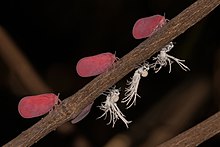| Flatidae | |
|---|---|

| |
| adult bugs and nymphs (Flatida rosea) Ankarana Reserve, Madagascar | |
| Scientific classification | |
| Domain: | Eukaryota |
| Kingdom: | Animalia |
| Phylum: | Arthropoda |
| Class: | Insecta |
| Order: | Hemiptera |
| Suborder: | Auchenorrhyncha |
| Infraorder: | Fulgoromorpha |
| Superfamily: | Fulgoroidea |
| Family: | Flatidae |
| Subfamilies | |


Flatidae are a family of fulgoroid planthoppers. They are cosmopolitan in distribution and are distinguished from others in the superfamily by a combination of characters. Like all other planthoppers, they suck phloem sap of plants. Some species are known to communicate with vibrations through the plant stems.[1] Communication may be with mates, or with ants that tend the nymphs, protecting them and gathering honeydew secretions.[2] Adults of some species have brightly coloured forewings which are tougher and known as tegmina unlike the membranous hindwings which are used for flight. Although a few can be identified by their coloration, most species requires dissection and examination under a microscope with access to literature on already described species.[3]
There are two subfamilies within the family. In the subfamily Flatinae, the body of adults is flattened laterally and the tegmina are tent-like. In the Flatoidinae, the body is not laterally compressed and the tegmina are not as tent-like and sometimes held horizontally. The wing venation is distinctive in that the veins in the anal region are nodose, and the costal area has numerous cross veins.[4] The antennae are small and the first segment is collar-like and small. The second segment is longer and ends in a bulge and a flagellum arises from it. They have two ocelli. Nymphs have a tail of waxy filaments.
- ^ Virant-Doberlet, Meta; Žežlina, Ivan (2007). "Vibrational Communication of Metcalfa pruinosa (Hemiptera: Fulgoroidea: Flatidae)" (PDF). Ann. Entomol. Soc. Am. 100 (1): 73–82. doi:10.1603/0013-8746(2007)100[73:VCOMPH]2.0.CO;2.
- ^ Pfeiffer, Martin; Linsenmair,K.E. (2007). "Trophobiosis in a tropical rainforest on Borneo: giant ants Camponotus gigas (Hymenoptera: Formicidae) herd wax cicadas Bythopsyrna circulata (Auchenorrhyncha: Flatidae)". Asian Myrmecology. 1: 105–119.[permanent dead link]
- ^ Stephen W. Wilson (2005). "Keys to the families of Fulgoromorpha with emphasis on planthoppers of potential economic importance in the Southeastern United States (Hemiptera: Auchenorrhyncha)". Florida Entomologist. 88 (4): 464–481. doi:10.1653/0015-4040(2005)88[464:kttfof]2.0.co;2.
- ^ F. Muir (1923). "On the classification of the Fulgoroidea (Homoptera)" (PDF). Proceedings of the Hawaiian Entomological Society. 5 (2): 205–247.